|
Dec
11
2023
|
|
Posted 2 years 20 days ago ago by Admin
|
|
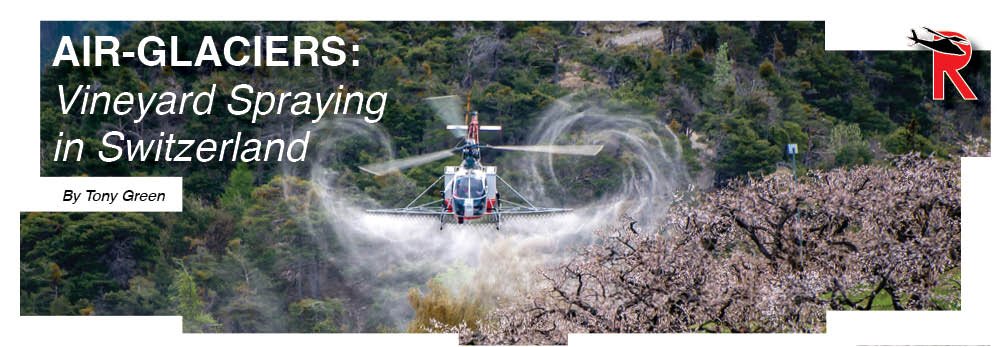
VIEW VIDEO
After many testing phases and successful results since 1953, aerial treatments have only been operated since the 1970s. The society Trans-Héli SA was created to continue the development of this relatively new way to reach land plots located in difficult places. In Switzerland, mainly in the cantons of Vaud and Valais, the target plots are in the mountains and very steep. Air-Glaciers SA, the local helicopter company based in Sion, services this hard-to-reach agricultural land, flying in from the air above.
An essential tool
Nowadays mainly used for the treatment of vineyards and apricot trees, the helicopter has proven its effectiveness on many levels. Its quick reactivity has also enabled it to win battles on a larger scale. Emergency fights against beetles, potato mildew, and other crop cripplers, the helicopter has proven to be a major ally to Swiss farmers. Equipped with a tank and spray bars, the helicopter has truly become an essential tool.
From 2010, the company has expanded its offerings with a “shading” service that allows farmers to maintain a stable temperature for their crops. This procedure has the advantage of reducing direct sunlight on crops by applying a simple mixture of chalk and water (aka. liming). Other services were created once customers realized that helicopters were not only a good idea, but a mandatory tool. For example, Air-Glaciers plants seeds on ski slopes after winter and spreads Bauxite (a sedimentary rock) to melt snow on mountain worksites. The operator’s spray equipment is also used in helicopter flight training for vortex cases.
Air-Glaciers first tested their spray of biological products over vineyards and fruit trees. Since 2013, these products have been approved and commercially available. As the demand for this service has greatly increased, these biological products now represent more than 80% of the company’s sprayed products.
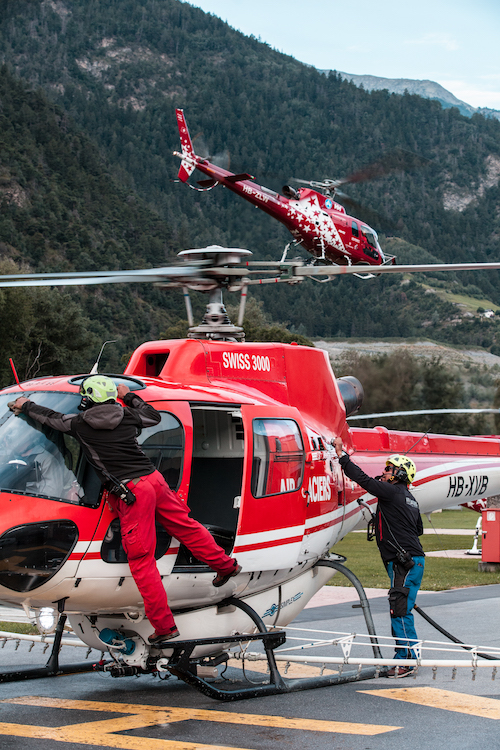
For more than 40 years, Air-Glaciers has been serving Swiss agriculture. They flew an SA315 Lama until 2021, which has been replaced by the Ecureuil AS350-B2 for fuel efficiency and reduced noise. The aircraft is also appreciated for its exceptional agility and for its power-to-weight ratio.
Spray Season
Apricot tree spraying begins in April, and vineyard spraying happens from mid-May until mid- August. Air-Glaciers operates three H125s/AS350-B2s fully equipped for spraying, which means three complete months of spray treatments for 550 hectares of vineyards. Generally, the same 20-person team is dedicated to this task every year to ensure experienced collaboration between pilots, assistants, and farmers.
The helicopters are only dedicated to spray during this treatment season. Interestingly, the aircraft is equipped with a 600-litre tank but only filled with 500 litres because the product generates foam and can overflow. The spray is a non-toxic, fungicide with a toxicity class of zero. (In Switzerland, it is strictly forbidden to spray herbicide or insecticide from a helicopter.) The product is controlled and prepared by external certified experts. The reduced volume is also a matter of flight performance; when the weather is too warm, the pilot needs the reduced weight to do the acrobatics the targeted spraying requires.
Two spray poles are controlled by the pilot with an electric quick-release system on the cyclic. The preparation and set up of such a system (pumps, poles, and tanks) needs an entire day, with a half-day to set it up. (This explains why the helicopters are only dedicated to this task in summer.)
In the cockpit, the pilot has a digital tablet that maps the plots concerning him, It provides real-time updates of the land as it’s treated. In addition, farmers are present on the ground and in permanent radio contact with the pilot to ensure that each spraying covers the desired plot.
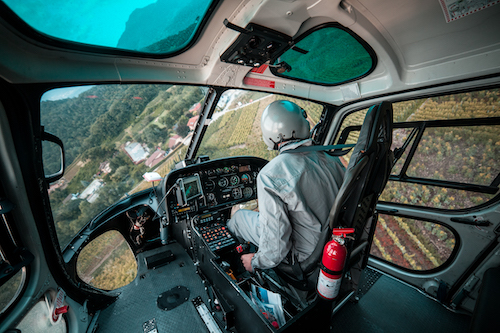
INSIGHT from Sebastien Widmer, pilot
As a pilot, what do you need to do to make a spray mission a success?
The key to success in this mission is strong knowledge of the terrain. You must know all the potential obstacles, by spending many hours on the ground and visiting the plots. There's a lot of computer work to define a treatment circuit, because you must start spraying at a precise point and follow a flight plan until the end of the spraying session.
People from vineyards follow us on the ground to make sure that roads are blocked in certain areas where traffic is heavy. The pilot must be aware of currents, for example: if there's a wind descending the terrain, the pilot will start work at the bottom of the vines and then continue up to the upper plots to avoid flying into the spray and dirtying the aircraft windows. If the windows are smudged, you must be able to fly up to 25 minutes before returning to the filling site without a clear view outside, which is risky and not comfortable. The position of the sun is also decisive for flight itineraries; you can't work with the sun in your eyes when you're so close to the ground.
Training and Guidance
It takes three years of training to do this precision aerial work, which means about 100 hours of flight. The first year, the future pilot learns at the side of the pilot, the second year he has dual commands on the helicopter but without the spray trigger, and the last year he takes the double commands and manages the entire process. They fly approximately two meters above the top of the crops (apricot trees or vines) with a speed of about 50 km/h to maintain a constant flow rate.
The pilot flies following lines. Signs with numbers and different colors are displayed in the plots. The signs have different codifications and show orientation. The pilot knows the direction to take, the line to follow, and which plots are untreated. In addition, the plots are all oriented differently so that the pilot does not confuse the colors with the backlight.
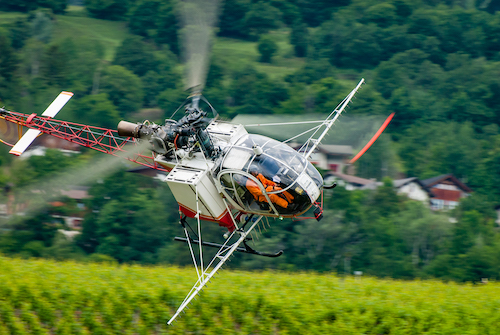
Revealing papers that react to the spray are positioned on the ground in order to indicate if the entire target has been covered. Each plot must be treated three to seven times during the season, to ensure disease prevention and a healthy harvest.
Before beginning a treatment, the Air-Glaciers team goes to each plot to analyze the situation and have a meeting with the farmers. This quick briefing is important for the pilot as the plots are steep and do not allow for mistakes. They must know everything like if there are new cranes in the field or electric pylons.
The flight time over a plot is also optimized in order to work efficiently and safely as possible. Each second matters; each vineyard plot must be sprayed.
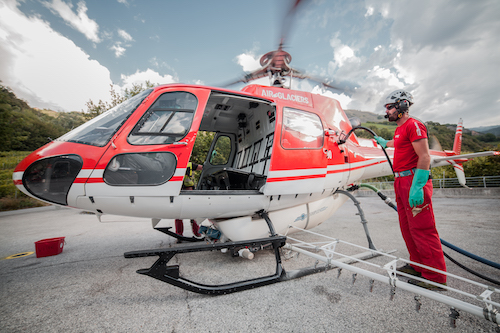
INSIGHT from Alexandre Lamon, flight assistant
Which is a key element to succeed in this type of mission?
The most important thing is to have good collaboration between the pair of flight assistants and the pilot. Without a lot of words, we need to be efficient and safe. The knowledge of the helicopter is also important. The spray equipment is not fully visible by the pilot. The task of the flight assistant is to ensure the spray process and fueling are done correctly, and to check all the equipment.
Morning in the Swiss Vineyards
Each summer day, an artistic, avionic ballet takes place over the Swiss vineyards.
The dance begins early in the morning before sunrise because the spray cannot be spread over 25°C (77℉). The day must be without rain and wind to maximize efficiency and to avoid spraying where it is not needed (cars, houses, roads).
In preparation, the helicopters are landed far from houses to not disturb people when they first takeoff in the morning. Pilots and flight assistants meet before sunrise and prepare the machines. Another flight assistant is already on site with the fuel truck and the cleaning tools. Winemakers are ready too and begin the meeting with the pilots. Briefing is done by the pilot, analyzing wind direction and sun position. (It is impossible to fly at such a low altitude facing the sun.)
All are ready, the helicopter can operate too.
The flight assistant fills the tank with the fungicide, the pilot does a spray test, and they can spray until the weather becomes too warm. After each takeoff, the winemaker and the flight assistant already prepare the next plots that must be covered.
Once the helicopter is back, the first flight assistant takes care of the refuelling if needed and refills the tank with the spray. The second flight assistant cleans the windshield, the cell windows, and checks the mechanics.
Considering the numerous areas they have to cover, the pilot and the assistants know their job by heart. It is precision ballet; they operate quickly and precisely with the help of the vineyard owner. They communicate together with radios to know exactly where the plot begins and ends. If you harbor any doubts about how tricky this work is, consider that one owner can have several plots in the middle of other owners' plots. Precision is the key word, and the pilots are the most experienced ones. They also must also avoid dangerous power lines in addition to overcoming all their other difficulties.
The amazing work provided by the team of Air-Glaciers has a big impact on preserving the grapes and the fruits of diseases and insects. Thanks to them, the local harvests can be successful.
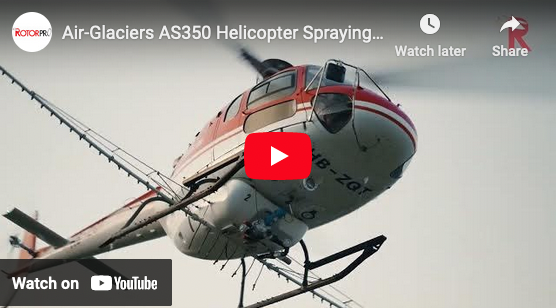
VIEW VIDEO
READ MORE SEP/OCT ISSUE
READ MORE ROTOR PRO: https://justhelicopters.com/Magazine
WATCH ROTOR PRO YOUTUBE CHANNEL: https://buff.ly/3Md0T3y
You can also find us on
Instagram - https://www.instagram.com/rotorpro1
Facebook - https://www.facebook.com/rotorpro1
Twitter - https://twitter.com/justhelicopters
LinkedIn - https://www.linkedin.com/company/rotorpro1